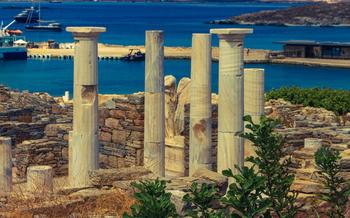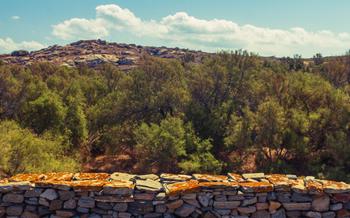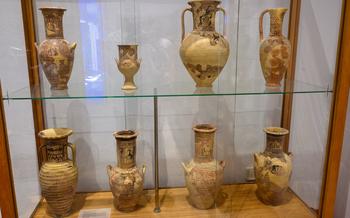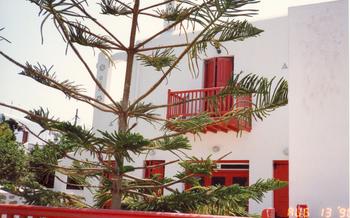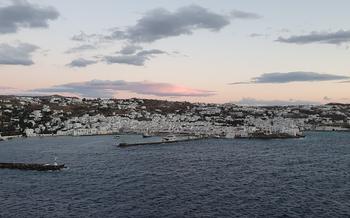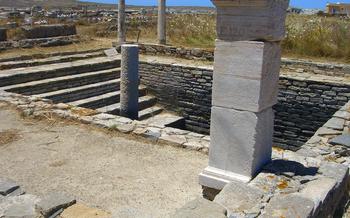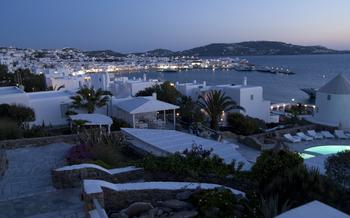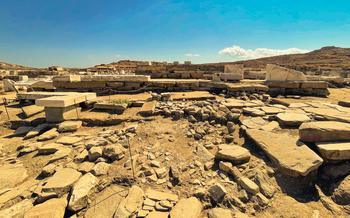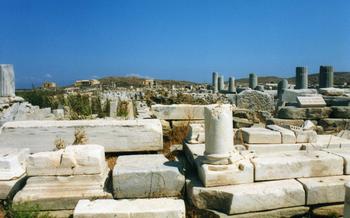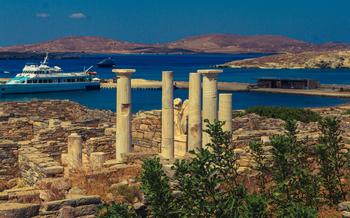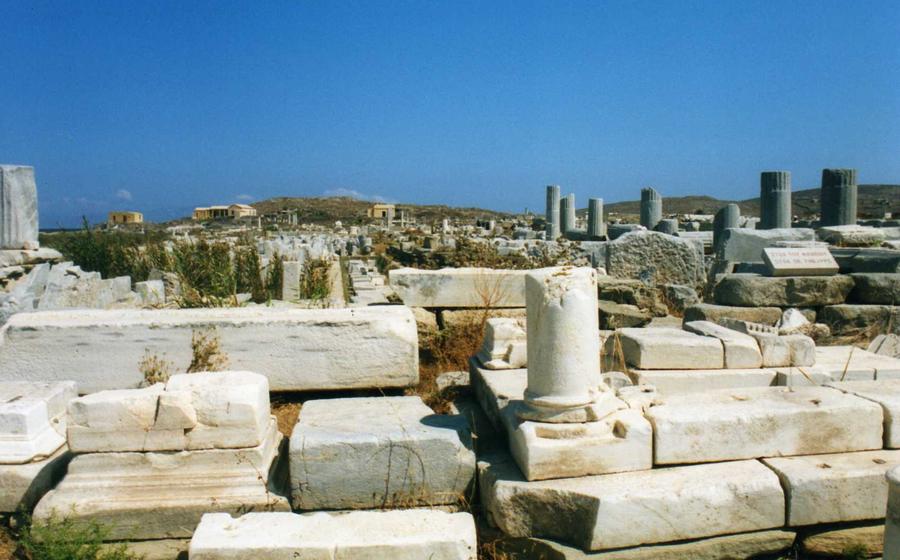
House of Dionysus at Delos
- Journey Through Time: Delos Unveiled
- Transportation to Delos: Embark on a Voyage
- Delos' Entrance and Facilities: Prepare for Exploration
- Exploring the House of Dionysus: A Room-by-Room Journey
- Mythological Tales Woven into the Mosaics
- Unraveling the Mysteries of the House of Dionysus
- Other Must-See Landmarks in Delos: Enrich Your Experience
- Tips for a Rewarding Visit to the House of Dionysus
- Capture the Essence of the House of Dionysus Through Photography
- Delos Beyond the House of Dionysus: Discover More Treasures
- Suggested Itineraries for Delos Exploration
- Recommended Tours for a Comprehensive Experience
- Delos and Mykonos: A Perfect Pairing for Island Hopping
- Insider Tip: Unveiling Delos' Hidden Gem
Journey Through Time: Delos Unveiled
Delos, a small island in the Aegean Sea, holds a prominent place in Greek mythology and history. It is believed to be the birthplace of the twin gods Apollo and Artemis, and was considered one of the most sacred islands in ancient Greece. The island was also a major religious and commercial center, and its archaeological remains, which date from various periods, have earned it the status of a UNESCO World Heritage Site.
Delos is a treasure trove of ancient ruins and artifacts, offering visitors a glimpse into the rich history and culture of ancient Greece. The island is home to numerous temples, theaters, and other public buildings, as well as private residences and shops. The most famous landmark on Delos is the Terrace of the Lions, a row of seven marble lions that once guarded the entrance to the Sanctuary of Apollo.
Delos' mythological significance is undeniable. The island was said to be the birthplace of Apollo and Artemis, the children of Zeus and Leto. Apollo was the god of music, poetry, and prophecy, while Artemis was the goddess of the hunt, wilderness, and childbirth. Delos was also home to the Oracle of Apollo, which was consulted by people from all over the ancient world.
In ancient times, Delos was a major religious and commercial center. The island was home to a number of temples and sanctuaries, which were visited by pilgrims from all over Greece. Delos was also a major trading center, and its port was frequented by ships from all over the Mediterranean.
Transportation to Delos: Embark on a Voyage
Journey to Delos by Ferry: Delos, the sacred island of antiquity, lies a mere 30-minute ferry ride away from the cosmopolitan island of Mykonos. Regular ferries depart from Mykonos' Old Port, whisking you away to a realm steeped in myth and history. The journey offers breathtaking views of the Aegean Sea, with the barren yet captivating landscape of Delos gradually emerging on the horizon.
Ferry Schedules and Prices: Ferries to Delos operate daily, with departures typically starting from 9:00 AM and the last ferry returning around 5:00 PM. The frequency of ferries varies depending on the season, with more frequent departures during the peak tourist season. Ticket prices are reasonable, ranging from 20 to 30 euros for a round trip.
Guided Tours: A Comprehensive Experience: For a more immersive and informative experience, consider booking a guided tour to Delos. These tours often include round-trip ferry tickets, as well as the services of a knowledgeable guide who will lead you through the island's ancient ruins and share fascinating insights into its history and mythology. Guided tours typically last around four hours and offer a comprehensive overview of Delos' key landmarks.
Independent Travel: A Journey of Discovery: If you prefer a more independent exploration, you can easily reach Delos on your own. Simply purchase a ferry ticket at the Old Port and make your way to the departure gate. Once on the island, you can follow the well-marked paths and signage to navigate the archaeological site. Independent travel offers the flexibility to explore at your own pace and allows you to linger longer at the places that capture your interest.
Delos' Entrance and Facilities: Prepare for Exploration
Before embarking on your exploration of Delos, it's essential to familiarize yourself with the entrance and facilities available to ensure a smooth and enjoyable visit.
Ticket Prices: - Individual tickets: Regular ticket prices for adults typically range between 12-15 euros. - Group discounts: Discounted rates may be available for groups, often requiring a minimum number of participants. - Concession rates: Reduced prices are offered to students, seniors, and individuals with disabilities upon presentation of valid identification.
Opening Hours: - Seasonal variations: Delos' opening hours vary depending on the season. During peak tourist months, the site is generally open from 8:00 AM to 8:00 PM. Off-season hours may be shorter, so it's advisable to check the official website for up-to-date information. - Special arrangements: On certain days, such as public holidays or special events, the opening hours may be extended or modified. It's recommended to inquire about any special arrangements in advance.
Visitor Center: - Location: The visitor center is conveniently situated near the entrance of the archaeological site. - Services offered: The visitor center provides a wealth of resources to enhance your visit, including informative brochures, maps, and guidebooks. Additionally, you can purchase tickets, seek assistance from knowledgeable staff, and store your belongings in lockers.
Accessibility: - Considerations for visitors with disabilities: Delos is committed to ensuring accessibility for all visitors. While some parts of the site may be challenging to navigate due to uneven terrain and cobblestone paths, there are ramps and accessible routes available. Visitors with disabilities are encouraged to contact the visitor center for assistance or inquire about the availability of wheelchairs or other mobility aids.
Exploring the House of Dionysus: A Room-by-Room Journey
The House of Dionysus boasts a captivating layout, inviting visitors to embark on a room-by-room exploration. The main entrance sets the stage, featuring a grand threshold that symbolizes transition and welcomes guests into the opulent abode. The central courtyard, the heart of the house, serves as a gathering space surrounded by elegant columns and adorned with intricate mosaics.
Venturing further, the triclinium, or dining room, captivates with its stunningly preserved mosaics depicting mythological scenes and vibrant wall paintings. The reception room, adjacent to the triclinium, exudes grandeur with its decorative features, serving as a space for hosting guests and engaging in lively conversations.
The kitchen, though smaller in size, offers a glimpse into ancient culinary practices, revealing the tools and techniques used to prepare sumptuous meals for the house's inhabitants. Each room unfolds a new chapter in the story of the House of Dionysus, providing visitors with a vivid glimpse into the lavish lifestyle and cultural significance of this ancient sanctuary.
Mythological Tales Woven into the Mosaics
The mosaics that adorn the floors and walls of the House of Dionysus are not merely decorative; they are intricate tapestries woven with mythological tales and allegorical meanings. Each mosaic is a masterpiece of storytelling, vividly depicting scenes from Greek mythology and showcasing the artistic prowess of ancient craftsmen.
In one mosaic, the god Dionysus is portrayed in a triumphant procession, riding a chariot drawn by panthers and surrounded by a retinue of satyrs and maenads. The procession symbolizes Dionysus' triumph over his enemies and his joyous return to Mount Olympus.
Another mosaic depicts the birth of Dionysus from the thigh of Zeus, a powerful and symbolic representation of the god's divine origins. The scene is rendered with great detail, capturing the moment when the infant Dionysus emerges from Zeus's thigh, fully formed and radiant.
The mosaics also feature scenes from Dionysus' many exploits and adventures. In one mosaic, the god is shown battling the giants, a formidable race of beings who challenged the authority of the gods. Dionysus is depicted as a fierce and powerful warrior, wielding his thyrsus, a staff topped with a pine cone, as his weapon.
The mosaics of the House of Dionysus are not just beautiful works of art; they are also valuable sources of information about Greek mythology and the beliefs and practices of ancient Greek society. Through these mosaics, we can glimpse the rich tapestry of stories and legends that shaped the lives of the ancient Greeks.
Unraveling the Mysteries of the House of Dionysus
Archaeological discoveries at the House of Dionysus have shed light on the vibrant life and culture of ancient Delos. Ongoing excavations continue to uncover new artifacts and insights, contributing to our understanding of the house's historical significance.
The house's well-preserved mosaics and frescoes provide a glimpse into the artistic and cultural influences that shaped Delos during the Hellenistic period. These intricate artworks depict mythological scenes, daily life, and religious rituals, offering a unique window into the beliefs and practices of the ancient Greeks.
Preservation efforts at the House of Dionysus have been instrumental in safeguarding this remarkable site. Archaeological teams have employed various techniques to protect the delicate mosaics and frescoes from the elements and the passage of time. These efforts include careful restoration work, the use of protective coverings, and the implementation of sustainable conservation practices.
Ongoing research at the House of Dionysus aims to uncover further secrets and shed light on the house's role in Delos' ancient society. Scholars are studying the architectural features, analyzing the artifacts, and interpreting the iconography of the mosaics to gain a deeper understanding of the house's function, its inhabitants, and its place in the broader context of Delos' history.
Other Must-See Landmarks in Delos: Enrich Your Experience
Beyond the House of Dionysus, Delos boasts a wealth of other captivating landmarks that offer a comprehensive insight into its rich history and cultural significance. Here are some must-see attractions to enhance your exploration of this ancient island:
-
Terrace of the Lions: As you approach the archaeological site, you'll be greeted by the awe-inspiring Terrace of the Lions, featuring a row of majestic marble lion statues that once guarded the sacred precinct of Apollo. These impressive sculptures, dating back to the 7th century BC, exude a sense of power and grandeur, while offering breathtaking panoramic views of the surrounding landscape.
-
Agora of the Italians: Delve into the bustling commercial heart of ancient Delos at the Agora of the Italians, a well-preserved marketplace dating from the 2nd century BC. Explore the remarkably intact stoas, or covered walkways, lined with shops and stalls that once teemed with activity. Imagine the vibrant atmosphere as merchants traded goods, locals bartered for necessities, and visitors sought exotic treasures from distant lands.
-
Sanctuary of Apollo: At the core of Delos lies the Sanctuary of Apollo, the island's most significant religious site. Dedicated to the revered god of music, poetry, and prophecy, this sacred precinct encompasses an array of impressive ruins, including the Temple of Apollo, the Altar of Horns, and the Naxian Terrace. Admire the architectural finesse of these ancient structures and immerse yourself in the spiritual aura that once permeated this sacred ground.
-
Mount Kynthos: Embark on a scenic hike to the summit of Mount Kynthos, the highest point on Delos. As you ascend, marvel at the breathtaking vistas that unfold before you, encompassing the entire island, the shimmering Aegean Sea, and the neighboring islands. Discover ancient remains along the way, including fortifications, cisterns, and a sanctuary dedicated to Zeus Hypsistos, the supreme god. The panoramic views from the peak are simply unforgettable, providing a fitting climax to your exploration of Delos.
Tips for a Rewarding Visit to the House of Dionysus
To make the most of your visit to the House of Dionysus, consider these practical tips:
-
Timing is key: Aim to visit during the shoulder seasons (May-June and September-October) to avoid the peak tourist crowds. Early mornings or late afternoons offer the best lighting for photography and a more tranquil atmosphere.
-
Comfortable footwear: The archaeological site involves walking on uneven terrain and cobblestone paths. Choose comfortable shoes with good support to ensure a pleasant exploration experience.
-
Sun protection: Delos is an exposed archaeological site with limited shade. Sunscreen, a hat, and sunglasses are essential to protect yourself from the strong Greek sun.
-
Hydration: Stay hydrated, especially during warm weather. Bring a reusable water bottle and refill it at the visitor center or nearby cafes.
Capture the Essence of the House of Dionysus Through Photography
The House of Dionysus presents a remarkable opportunity for photography enthusiasts to capture the essence of ancient Greek art and architecture. To ensure sharp and stable images, a tripod is highly recommended. Utilizing natural light is crucial, as the interplay of shadows and highlights adds depth and dimension to the photographs. Experiment with various composition techniques to create visually appealing shots, such as leading lines, symmetry, and depth of field. Remember to respect the photography guidelines set forth by the archaeological site to preserve the integrity of the House of Dionysus and its surroundings.
Delos Beyond the House of Dionysus: Discover More Treasures
While the House of Dionysus is a must-see attraction, Delos offers a wealth of other captivating landmarks that further enrich the island's historical and cultural significance. The Archaeological Museum of Delos, located near the harbor, houses a remarkable collection of artifacts unearthed during excavations on the island. Here, visitors can admire sculptures, pottery, jewelry, and other objects that provide a glimpse into the daily lives and artistic achievements of the ancient Delians.
The Ancient Theater, situated on the slopes of Mount Kynthos, is a testament to Delos' vibrant cultural life. Constructed in the 3rd century BC, the theater boasts well-preserved seating and impressive acoustics, allowing visitors to experience the atmosphere of a classic Greek theater.
The Sacred Harbor, once the bustling gateway to Delos, played a crucial role in the island's commercial and religious activities. Today, visitors can explore the harbor's remains, including ancient warehouses, jetties, and a monumental gateway that welcomed ships from across the Mediterranean.
Finally, the Little Theater, located near the Sanctuary of Apollo, offers an intimate setting for performances and gatherings. Despite its smaller size, the theater features well-preserved seating and intricate architectural details, providing a glimpse into the diverse entertainment options enjoyed by the ancient Delians.
These additional landmarks, each with its own unique story to tell, complement the House of Dionysus and create a comprehensive tapestry of Delos' rich history and cultural heritage.
Suggested Itineraries for Delos Exploration
Half-Day Trip:
- Morning: Catch the early ferry from Mykonos to Delos, arriving at 9:00 AM.
- 9:00 AM to 11:00 AM: Explore the House of Dionysus, marveling at its intricate mosaics and frescoes.
- 11:00 AM to 12:00 PM: Wander through the Terrace of the Lions, admiring the iconic statues and panoramic views.
- 12:00 PM to 1:00 PM: Enjoy a delightful lunch break at one of the tavernas on Delos, savoring the flavors of traditional Greek cuisine.
- 1:00 PM to 3:00 PM: Visit the Archaeological Museum of Delos to gain insights into the island's rich history and culture.
Full-Day Adventure:
- Morning: Take the 9:00 AM ferry from Mykonos to Delos.
- 9:00 AM to 11:00 AM: Embark on a guided tour of the House of Dionysus, delving into its historical significance and artistic wonders.
- 11:00 AM to 12:00 PM: Explore the Terrace of the Lions, capturing breathtaking views of the Aegean Sea.
- 12:00 PM to 1:00 PM: Enjoy a leisurely lunch at a local taverna, savoring the local delicacies.
- 1:00 PM to 3:00 PM: Visit the Archaeological Museum of Delos to learn about the island's fascinating past.
- 3:00 PM to 4:00 PM: Discover the ancient Agora of the Italians, where merchants once traded their goods.
- 4:00 PM to 5:00 PM: Witness the grandeur of the Sanctuary of Apollo, the religious heart of Delos.
- 5:00 PM to 6:00 PM: Ascend Mount Kynthos, the highest point on Delos, for panoramic views and a glimpse into the island's natural beauty.
Multi-Day Journey:
Immerse yourself in the timeless charm of Delos with a multi-day journey, allowing ample time to explore its hidden gems and delve into its rich mythology and history. Stay overnight at one of the charming guesthouses on the island to fully embrace its tranquil ambiance.
Recommended Tours for a Comprehensive Experience
When visiting Delos, guided tours can significantly enhance your experience, offering expert insights and organized itineraries. Group tours provide a cost-effective option, allowing you to learn from knowledgeable guides and share the adventure with fellow travelers. Reputable tour operators, such as GetYourGuide and Viator, offer various group tours with flexible departure times and prices.
For a more personalized experience, private guided tours are an excellent choice. These tours can be customized to your interests and pace, ensuring you cover the sights that matter most to you. Several local tour companies, including Delos Tours and Mykonos Yachting, offer private tours with experienced guides who can tailor the itinerary to your needs.
If you prefer the freedom to explore at your own pace, self-guided tours are a great option. You can purchase a guidebook or download a mobile app to navigate the site independently. However, keep in mind that you may miss out on valuable insights and historical context without a guide.
Delos and Mykonos: A Perfect Pairing for Island Hopping
Delos and Mykonos, two neighboring islands in the Aegean Sea, offer a compelling combination of ancient history and modern allure. While Delos captivates with its archaeological wonders, Mykonos enthralls with its vibrant atmosphere, stunning beaches, and cosmopolitan charm.
Ferries regularly ply the waters between Delos and Mykonos, making island hopping a breeze. The journey takes approximately 30 minutes, providing ample opportunities to soak in the breathtaking views of the Aegean.
Once in Mykonos, visitors are greeted by a kaleidoscope of experiences. The town of Mykonos, with its whitewashed houses, charming boutiques, and lively nightlife, beckons with its vibrant energy. Paradise Beach and Super Paradise Beach, renowned for their crystal-clear waters and pulsating beach clubs, offer a slice of paradise for sun-seekers and party enthusiasts.
For those seeking a deeper cultural immersion, Mykonos Town boasts an array of museums, including the Archaeological Museum of Mykonos, which houses a collection of ancient artifacts from Delos and other Cycladic islands. The Mykonos Folklore Museum provides a glimpse into the island's rich traditions and customs.
Whether exploring the ancient ruins of Delos or basking in the vibrant atmosphere of Mykonos, island hopping between these two gems of the Aegean promises an unforgettable experience. With its proximity to Athens, it's an ideal destination for history buffs, beach lovers, and those seeking a quintessential Greek island adventure.
Insider Tip: Unveiling Delos' Hidden Gem
Beyond the renowned House of Dionysus, Delos holds another hidden treasure – the House of the Dolphins. This lesser-known gem is tucked away in the residential district, offering a glimpse into the daily lives of Delos' ancient inhabitants.
The House of the Dolphins takes its name from the intricate mosaic depicting a group of dolphins frolicking in the sea. This beautiful artwork adorns the floor of the central courtyard, surrounded by well-preserved rooms and living spaces.
While smaller in size compared to the House of Dionysus, the House of the Dolphins offers an intimate glimpse into the domestic architecture and lifestyle of Delos' residents. The house features a series of interconnected rooms, including a kitchen, dining room, and bedrooms, providing a tangible connection to the daily routines of the past.
Exploring the House of the Dolphins is like stepping back in time, allowing visitors to imagine the lives of ordinary people who called Delos home. It's a hidden gem that offers a unique perspective on this ancient island, complementing the grander landmarks and providing a more comprehensive understanding of Delos' rich history.
